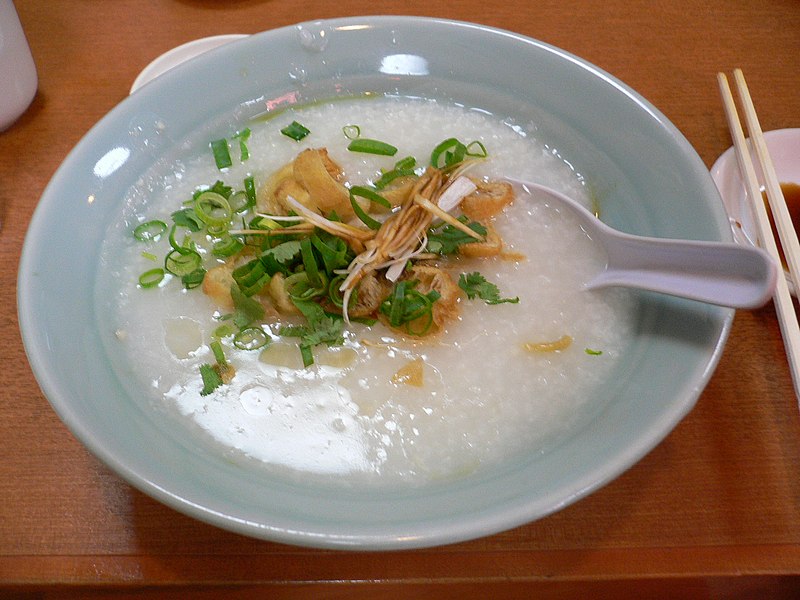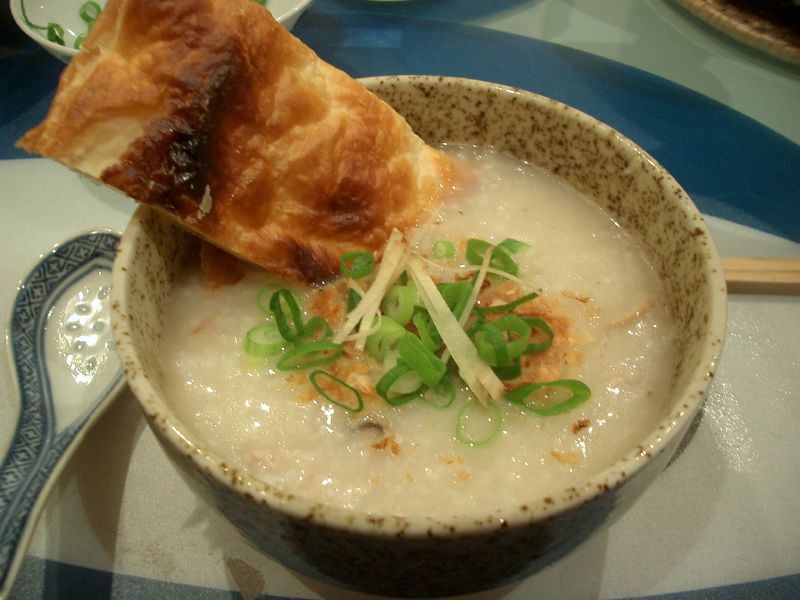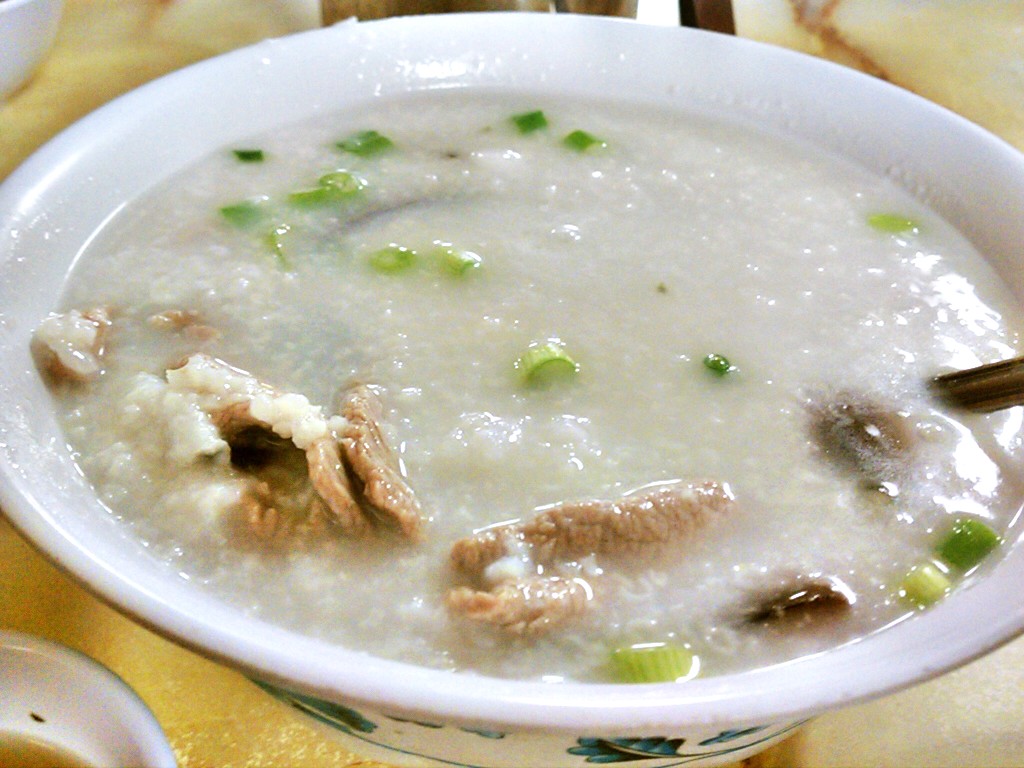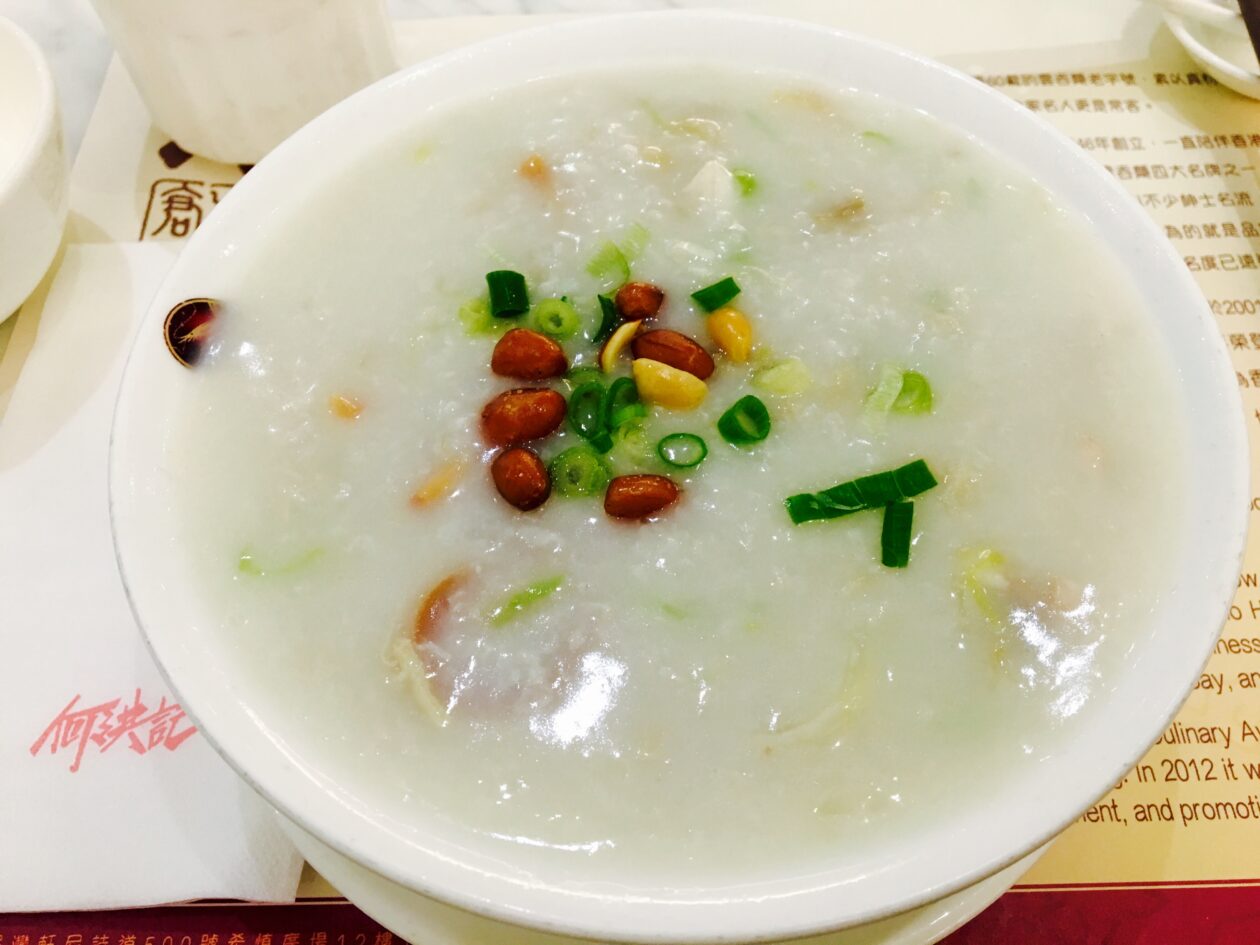Introduction
Congee, sometimes called rice gruel or porridge, is a classic Asian food enjoyed for millennia. The recipe calls for boiling a large amount of rice in broth or water until it becomes thick and creamy. Congee is a mainstay in many homes due to its ease of preparation, adaptability, and comforting characteristics; it’s especially popular during illness or as a hot supper on chilly days.
Congee’s possible health advantages have drawn more attention in recent years, especially in light of its potential to help with weight loss. Many people are interested in whether including Congee in their diet might help them achieve their weight loss objectives. This article aims to examine Congee’s function in weight control by presenting information on its nutritional makeup, advantages for digestion, and possible effects on general health. We want to provide an answer to the question: Is Congee good for weight loss? by looking at both conventional wisdom and contemporary science.
This post will examine Congee’s nutritional makeup and how it stacks against other rice-based meals. We’ll also talk about Congee’s hydrating qualities, benefits for the digestive system, and ability to promote a healthy metabolism. We’ll also look at personal accounts, professional judgments, and conventional wisdom to give you a thorough grasp of whether Congee can be a helpful complement to a weight loss program. By the time it’s all through, readers will know more about the part congee can play in helping them reach their weight loss objectives.
Understanding Congee
Congee, sometimes called rice porridge or rice gruel, originated in ancient China when it was a common meal in many homes. This is a very easy but filling dish produced by cooking rice in water or broth until it becomes thick and creamy. Congee has developed throughout time into a variety of regional varieties found throughout Asia, each with distinctive flavors and components. Despite its modest beginnings, Congee has become well-known worldwide for its calming qualities and comforting flavor.
The nutritional profile of Congee is a major component that draws in those trying to control their Weight. Congee is a good option for anyone trying to cut back on calories because it’s low in fat and calories. It also contains a lot of carbs, making it a useful energy source for daily tasks. Congee is also highly digestible, which makes it perfect for anyone with sensitive stomach or digestive problems. It’s important to remember that Congee’s nutritional value might change based on the components and preparation technique.
The Key Nutritional Facts for Congee (Nutritionvalue)
- Calories: One cup (249g) of Congee contains 82 calories.
- Fat: A serving of Congee contains 0.2g of total fat, with 0.1g being saturated fat. It is categorized as a low-fat food.
- Protein: Each serving provides 1.7g of protein, contributing to satiety and muscle maintenance during weight loss.
- Carbohydrates: Congee contains 18g of carbohydrates per serving, with 0g of sugar and 0.3g of dietary fiber. The remaining carbohydrates are complex carbs.
- Sodium: It contains 630mg of sodium per serving, which should be considered for those watching their sodium intake.
- Vitamins and Minerals: While Congee is not particularly rich in vitamins, it does provide essential minerals like iron (0.75mg) and calcium (14.94mg) per serving.
- Other Nutrients: Congee is low in cholesterol and does not contain significant amounts of vitamins A, C, or D.
There are many types of Congee, each with a distinct flavor and texture combination. Congee frequently contains chicken, pork, fish, vegetables, flavors, and spices. It is a versatile and customized option for those wishing to incorporate Congee into their weight loss journey because each addition adds unique flavor and nutritional advantages to the dish. There are countless options to meet your dietary requirements and taste preferences, whether you’d rather make a straightforward chicken congee or a more complex seafood congee.
Congee is highly valued in traditional Chinese medicine (TCM) for its curative qualities and capacity to promote general health and well-being. According to TCM principles, Congee is considered mild on the stomach and easy to digest. This makes it a good choice for people who are recuperating from illness or have weak digestive systems. Congee is also frequently recommended as a component of a therapeutic diet to treat a range of medical conditions, such as exhaustion, inflammation, and digestive problems. Congee is a food people can eat to nourish their bodies and foster harmony and balance.
Exploring the Relationship Between Congee and Weight Loss

Congee’s low-calorie content is a major factor in its reputation as a weight-loss food. Congee is made by cooking rice in a lot of water or broth, which dilutes the number of calories per serving, in contrast to many other rice-based dishes. This implies that people can eat a filling serving of Congee without consuming too many calories, which makes it a good choice for people trying to control their Weight. Congee can help people achieve a calorie deficit—a necessary condition for weight loss—by taking the place of meals higher in calories.
Congee’s low glycemic index (GI) is another aspect that makes it an efficient weight-loss food. The GI gauges the pace at which a food’s carbs elevate blood sugar. Low-GI foods help you feel full and sated by gradually releasing glucose into your bloodstream and giving you lasting energy. Since rice has a lower GI than other grains and is the main ingredient in Congee, it can help stabilize blood sugar levels and reduce energy spikes and crashes. Those who want to control their hunger and cravings might benefit most from this, which will ultimately help them lose Weight.
Protein is a well-known macronutrient for weight loss, maintaining lean muscle mass, and increasing satiety. Despite its simple ingredients, Congee can be a surprisingly strong source of protein, especially when made with extra protein-rich items such as chicken, tofu, or seafood. People who consume protein at every meal will feel satisfied for longer, which lowers the chance of overindulging or between-meal snacking. Furthermore, compared to fats or carbs, protein requires more energy to break down, which increases total calorie expenditure and aids in weight loss.
The sensation of fullness and satisfaction following a meal is known as satiation and is essential for controlling Weight. Combining the rice’s fiber, watery broth, and possible protein level in Congee can help regulate appetite and promote feelings of fullness. People who consume a bowl of Congee can feel satisfied for a few hours afterward, lessening their desire to eat more meals or snacks. Congee’s cozy and warm qualities can also have a psychological impact, encouraging contentment and relaxation, which may help with weight loss by lowering stress-related eating habits.
Comparing Congee with Other Rice-based Dishes
To fully appreciate Congee’s special advantages for weight loss, it’s important to contrast it with other rice-based cuisines. Congee has a unique benefit over steaming white rice because it has fewer calories and carbs. Congee has far fewer calories and carbohydrates per serving than steamed white rice, which has about 140 calories and 31 grams of carbohydrates per 100 grams.
Congee’s cooking method, which entails simmering rice in a larger proportion of water or broth, is thought to cause this variation in calorie density while maintaining nutritional content. Therefore, Congee may be a more enjoyable and weight-friendly option than typical steamed rice for those trying to control their Weight.
Fried rice is another popular dish frequently connected to weight reduction issues. Fried rice usually contains more fat and calories than other types of rice because it is cooked with additional fats and oils, unlike Congee, which is made by cooking rice in water or broth. Because of its increased calorie density, fried rice might not be the greatest option for people trying to lose Weight despite its rich and decadent flavor.
Conversely, Congee is a healthier substitute that is lighter and more filling than fried rice. It may be a comfortable and fulfilling meal without the added fat or calories. People who prefer Congee to fried rice can still have a tasty and nutritious meal while progressing toward their weight loss objectives.
Another well-liked rice-based alternative that people could consider while looking for meals conducive to weight loss is rice noodles. Though they can be a good and adaptable option, rice noodles often have less nutritional value and more calories than Congee. Congee provides those trying to control their Weight with a more nutrient-dense and satisfying option due to its higher water content and possible addition of protein. Congee’s slower cooking method also improves nutritional absorption and digestion, helping weight loss and enhancing intestinal health. People can effectively assist their weight loss quest while enjoying a substantial and delicious lunch by opting for Congee instead of rice noodles.
Incorporating Congee into a Weight Loss Diet Plan

Preparing Congee and emphasizing nutrient-dense and low-calorie components is essential to losing Weight. Use whole-grain variants like brown or mixed-grain rice to boost fiber content and encourage fullness. Add lean protein sources, such as fish, tofu, or chicken breast, to your Congee to increase its nutritional content and assist muscle maintenance and metabolism. To enhance fiber and micronutrient intake, include a range of veggies, including spinach, mushrooms, and carrots. Try experimenting with spices and herbs like green onions, garlic, and ginger to add taste without adding unnecessary calories.
Use various nutritious items to turn your Congee into a nutrient-dense meal. Add poached eggs or egg whites during cooking for a high-protein choice. These foods provide vital amino acids necessary for muscle building and repair. Add heart-healthy fats to your Congee by adding sliced avocado or a drizzle of olive oil to enhance sensations of fullness and pleasure. Garnish your Congee with toasted nuts or seeds like almonds or sesame seeds to add texture and flavor while adding important nutrients like antioxidants and omega-3 fatty acids.
Even though Congee is a healthy complement to a weight-loss diet plan, portion control, and attentive eating are crucial. If you want to help manage portion sizes and stop overeating:
- Use smaller dishes or plates.
- Pay attention to hunger and fullness signs while eating mindfully and slowly, relishing every bite.
- Before meals, engage in mindfulness exercises like gratitude meditations or focused breathing to help foster contentment and avoid mindless eating. You may include Congee in a healthy, balanced weight loss plan by paying attention to portion sizes and your body’s hunger cues.
Think about pairing your Congee with other foods that are good for weight loss to maximize the effects of your efforts. Serve your Congee with stir-fried or steamed veggies to boost your fiber intake and make you feel fuller. Add lean protein sources, including tofu or grilled chicken breast, to maintain satiety and muscle preservation. You can experiment with diverse flavor combinations and promote gut health and digestion by including fermented foods like kimchi or pickled veggies. Congee can be combined with various nutrient-dense foods to make the filling, well-balanced meals to facilitate weight loss.
Addressing Common Concerns and Misconceptions
The idea that rice-based meals, such as Congee, are naturally high in fat is a prevalent one. Although rice does include carbs, which the body uses as fuel, controlling portion sizes and maintaining a balanced diet are the keys to losing Weight. Congee can be a filling and healthy dinner choice for anyone trying to reduce Weight when cooked with many veggies and lean protein sources. Congee can promote weight loss objectives while providing critical nutrients by utilizing a range of nutrient-dense ingredients and whole-grain rice varietals.
Though not all carbohydrates are made equal, they have a negative image when helping people lose Weight. The main ingredient in Congee, whole grain rice, has complex carbohydrates that support feelings of fullness and give long-lasting energy. Carbs can promote general health and well-being when eaten in moderation as part of a balanced diet. Instead of demonizing carbohydrates, select nutrient-dense, high-quality sources such as fruits, vegetables, and whole grains. By including these foods in your diet, you can assist your weight loss efforts and properly feed your body.
The salt content of Congee and its possible effects on weight control are other issues frequently brought up. While it’s true that some congee recipes call for more salt to enhance flavor, there are strategies to reduce your sodium intake without sacrificing the nutritional value of this food. When making Congee, use homemade stock or low-sodium broth, and use as little salt as possible during cooking. Incorporating abundant fresh veggies and herbs can also improve flavor without adding salt. You can enjoy Congee as part of a balanced diet that effectively supports your weight loss objectives by choosing whole, minimally processed components and being cautious of your sodium intake.
Congee as a Gut-Healthy Food

In Traditional Chinese Medicine (TCM), Congee has long been praised for its mild effects on the digestive tract. Congee is regarded in TCM philosophy as a filling, readily digestible food that generally promotes intestinal health. Its gentle texture and straightforward formulation make it perfect for those recuperating from illness or those with sensitive stomachs. Congee’s warming properties encourage blood flow and calm the digestive system, consistent with TCM’s emphasis on equating internal energies for maximum health.
Congee’s excellent digestion is one of its main advantages for digestive health. Congee is made by cooking rice grains until they become smooth and porridge-like, requiring less work from the digestive system to process. This can be especially helpful for those suffering from digestive discomfort or gastrointestinal problems. Congee’s high water content also aids in hydration, which is necessary for promoting gut health and a healthy digestive system.
According to recent research, the complex community of bacteria that live in the gastrointestinal system, known as the gut microbiota, may benefit from congee consumption. Rice’s prebiotic properties feed good gut flora and support a balanced, healthful population of gut microorganisms. Congee may enhance immune system performance, control metabolism, and improve gut health by providing the microbiome. This all-encompassing strategy for gut health emphasizes how crucial it is to include Congee in a balanced diet for long-term health.
Keeping your gut healthy is crucial for weight control since it affects several things, including metabolism, hunger control, and nutrition absorption. Congee is a great complement to any weight-loss diet plan because of its gut-friendly qualities. Because of its high fiber content, it helps control cravings and stop overeating by promoting feelings of fullness and satiety. Congee’s easy digestion and high moisture content also promote proper nutritional absorption, guaranteeing that the body gets the nutrients it needs without unduly taxing the digestive system. Congee can assist in reaching and maintaining a healthy weight by promoting digestive health.
Is Congee Good for Weight Loss?
A. Answer in Short: Congee can benefit weight loss due to its lower calorie and carbohydrate content than other rice-based dishes like steamed white rice. Its high protein content and greater water-to-rice ratio make it a filling and satisfying option to help control appetite and support weight management goals.
B. Answer in Depth with Value:
Congee, a traditional Asian rice porridge, offers several attributes that can support weight loss efforts. One of its key advantages is its lower calorie and carbohydrate content compared to other rice-based dishes. For example, while 100g of Congee contains approximately 65 calories and 7.5g of carbohydrates, the same amount of white rice contains 140 calories and 31g of carbohydrates. This lower calorie density can make Congee a more weight-loss-friendly option, especially when paired with lean protein sources such as chicken or fish.
Moreover, Congee’s higher protein content can contribute to feelings of fullness and satiety, which may help reduce overall calorie intake throughout the day. Protein is known to have a higher thermic effect than carbohydrates and fats, meaning that the body burns more calories during the digestion and metabolism of protein-rich foods. Individuals can enhance their weight loss benefits by incorporating protein-rich ingredients into Congee, such as chicken slices, tofu, or eggs.
Furthermore, Congee’s greater water-to-rice ratio ensures that it is more hydrating and voluminous than steamed white rice, providing a sense of fullness with fewer calories. Adequate hydration is essential for weight loss as it can help prevent overeating by keeping hunger at bay and supporting proper digestion and metabolism. Overall, while Congee alone may not guarantee weight loss, it can be a valuable addition to a balanced diet and lifestyle aimed at achieving and maintaining a healthy weight.
In summary, Congee can be a beneficial addition to a weight loss diet due to its lower calorie and carbohydrate content, higher protein content, and greater water-to-rice ratio than steamed white rice. By choosing lean protein sources and incorporating other weight-loss-friendly ingredients, individuals can maximize the satiating effects of Congee while supporting their overall weight management goals. However, it’s essential to remember that successful weight loss requires a comprehensive approach that includes regular physical activity, mindful eating habits, and lifestyle modifications.
Frequently Asked Questions about Congee and Weight Loss
Is Congee less fattening than rice?
Congee typically has a lower calorie and carbohydrate content than steamed white rice, making it a potentially less fattening option. Its greater water-to-rice ratio and higher protein content can contribute to feelings of fullness with fewer calories, making it a favorable choice for those looking to manage their Weight.
Is porridge good for you to Lose Weight?
Porridge, including varieties like Congee, can be a beneficial addition to a weight-loss diet. Its high fiber content and complex carbohydrates can help promote feelings of fullness, regulate blood sugar levels, and support healthy digestion. However, portion control and choosing nutrient-dense toppings are essential for maximizing its weight loss benefits.
Is porridge better than rice for weight loss?
Porridge, such as Congee, may offer certain advantages over plain rice for weight loss. Its lower calorie density, higher protein content, and greater water-to-rice ratio make it a more filling and satisfying option, potentially aiding in weight management efforts when consumed as part of a balanced diet.
How many calories are in a congee?
The calorie content of Congee can vary depending on ingredients and serving size. On average, one serving of Congee with chicken slices contains approximately 181 calories. However, this value may change based on additional toppings or variations in preparation methods.
Is it OK to eat Congee every day?
Eating congee daily can be part of a healthy diet, especially when paired with various nutrient-dense ingredients such as lean proteins, vegetables, and healthy fats. However, it’s essential to maintain balance and moderation in dietary choices to ensure adequate nutrient intake and overall well-being.
Is it good to eat Congee every day?
Congee can provide a nutritious and comforting option for daily consumption, particularly for individuals with sensitive stomachs or those seeking a gentle and easily digestible meal. Its versatility allows endless variations and customization to suit individual taste preferences and dietary needs.
Is Congee more fattening than rice?
Congee has a lower calorie and carbohydrate content than plain rice, potentially making it a less fattening option. Its higher water content and greater protein-to-rice ratio can contribute to feelings of fullness while providing essential nutrients, making it a favorable choice for weight management.
Is congee high calorie?
Congee can vary in calorie content depending on ingredients and serving size. While it is generally lower in calories than other rice-based dishes, adding certain toppings or ingredients may increase its calorie content. Choosing lean protein sources and incorporating plenty of vegetables can help keep Congee a relatively low-calorie option.
Is Congee bad for your stomach?
Congee is often recommended as a gentle and easily digestible food, making it suitable for individuals with sensitive stomachs or those recovering from illness. Its soft texture and high water content can help soothe the digestive system and provide nourishment during periods of gastrointestinal discomfort.
Is Congee high in sugar?
Congee typically does not contain added sugars unless sweetened with ingredients like honey or sugar. Congee is naturally low in sugar when prepared with savory ingredients, making it a suitable option for those monitoring their sugar intake.
Is Congee a diet food?
Congee can be considered a diet-friendly option due to its lower calorie and carbohydrate content than other rice-based dishes. Congee can provide a satisfying and nutritious meal that supports weight loss and overall health goals when prepared with lean proteins, vegetables, and healthy fats.
Does Congee have a lot of carbs?
Congee contains carbohydrates primarily from rice, but its carbohydrate content is generally lower than plain steamed rice. Adding protein-rich ingredients and fiber-packed vegetables can further balance its macronutrient profile, making it a well-rounded and satisfying meal option.
Does porridge spike insulin?
Porridge, including varieties like Congee, typically has a lower glycemic index than refined carbohydrates like white rice. This means it is less likely to cause a rapid spike in blood sugar levels and insulin response, making it suitable for those looking to manage or control insulin sensitivity.
Is Congee good for you when sick?
Congee is often recommended as a comforting and easily digestible food for individuals recovering from illness or experiencing digestive discomfort. Its gentle nature and soft texture can provide nourishment and hydration while being gentle on the stomach, making it a soothing choice during sickness.
Is Congee healthy?
Congee can be a healthy and nutritious meal with wholesome ingredients like lean proteins, vegetables, and whole grains. Its high water content, fiber, and essential nutrients make it a nourishing choice that supports overall health and well-being when consumed as part of a balanced diet.
Is Congee fattening?
Congee is a relatively low-calorie and filling option compared to other rice-based dishes, making it less fattening when consumed in moderation as part of a balanced diet. Choosing nutrient-dense toppings and controlling portion sizes help maximize its weight loss benefits while enjoying its comforting and satisfying qualities.
Conclusion
In this post, we have discussed Congee’s possible advantages and drawbacks while examining its connection to weight loss. We discussed how Congee, a classic Asian rice porridge, can be a filling and healthy choice for people trying to control their Weight. Congee can be a beneficial addition to a diet for weight loss, as we’ve shown by exploring its nutritional makeup, effect on satiety, and involvement in gut health.
Congee has several benefits for those who want to reduce their Weight. It’s a pleasant and filling lunch option because of its high water content, low-calorie content, and protein-rich components. Its mild and easily assimilated nature can aid gastrointestinal health and enhance general well-being. Congee can be an effective ally in reaching weight loss objectives while maintaining appropriate nutrition by adding nutrient-dense toppings and exercising portion control.
Finally, we urge readers to consider incorporating Congee into their weight loss regimen. But it’s crucial to approach dietary adjustments mindfully and in moderation. Although Congee has several advantages, it should be a part of a varied, balanced diet to guarantee sufficient nutrient intake. Readers can effectively utilize the potential benefits of Congee for weight management by adhering to a healthy lifestyle, selecting healthful components, and being cautious of portion sizes.
To Congee is a flexible and wholesome choice supporting a well-rounded weight loss strategy. Because of its versatility, it may be made in countless ways to suit a wide range of dietary requirements and taste preferences. Congee is a healthy and soothing food that promotes general health and well-being, whether eaten plain or with tasty toppings. People can start toward better eating habits and long-term weight loss by including Congee in a comprehensive weight-management strategy.
Reference
Traditional Chinese Medicine Information | Mount Sinai – New York. (2016). Mount Sinai Health System. https://www.mountsinai.org/health-library/treatment/traditional-chinese-medicine
Valdes, A. M., Walter, J., Segal, E., & Spector, T. D. (2018). Role of the gut microbiota in nutrition and health. The BMJ, k2179–k2179. https://doi.org/10.1136/bmj.k2179
Gunnars, K. (2016, August 18). Carbohydrates: Whole vs. Refined — Here’s the Difference. Healthline; Healthline Media. https://www.healthline.com/nutrition/good-carbs-bad-carbs
Congee nutrition facts and analysis. (2024). Nutritionvalue.org. https://www.nutritionvalue.org/Congee_56205101_nutritional_value.html
Was this helpful?

Joseph Emb, RDN
Founder of StyleVitally.com | Registered Dietitian & Wellness Advocate
What I Cover:
I’m passionate about connecting nutrition science and everyday wellness to help people live healthier, more vibrant lives. I write about evidence-based nutrition, mindful eating, sustainable lifestyles, and holistic well-being at StyleVitally.com.
My Background:
The University of Texas in Austin, where I earned my Dietetics diploma, laid the groundwork for my nutrition and health career. My training and hands-on experience taught me the science and art of using nutrition to enhance health and well-being.
Professional Journey:
I’m an RDN with lots of experience. I’ve helped people seeking tailored nutritional recommendations in clinical settings and community outreach programs. My constant learning and professional development ensure that my recommendations are always based on the latest evidence.
Ethical Commitment:
My practice prioritizes integrity. My content is transparent and objective, following the most significant ethical standards. I can give my audience unbiased advice because I’m not affiliated with food businesses or industry associations. I want to help people make informed health decisions that match their values and ambitions.
Join Me on the Wellness Journey:
Join me on the path to vitality and well-being, whether facing nutritional issues, seeking sustainable lifestyle changes, or simply wanting a better, happier you. We’ll discover how diet, mindfulness, and holistic well-being can maximize your potential.









